Bringing cohesion to life at community level: Lessons on effective narrative immersion
This case study records key lessons from a UK-based community organising campaign run by the Jo Cox Foundation called the Great Get Together (GGT). It’s a campaign inspired by Jo Cox – a Labour Member of Parliament – who was killed on the 16th of June 2016 by a far-right terrorist. The Jo Cox Foundation was established after her death to bring to life Jo’s famous message delivered in Parliament in 2016: “we have more in common than that which divides us”. For the past 6 years, the campaign has encouraged “people to come to together in their parks, on streets, at allotments or in community centres to make new connections with those from different backgrounds” and bring the more in common narrative to life.
While the Jo Cox foundation sees GGT as a community organising initiative and does not explicitly focus on a strategic communications model, the underlying principles and approach of bringing narratives to life though interaction overlaps significantly with the narrative immersion approach. This focus on immersion work in strategic communication shows how community level interventions that focus on building broader movements can play an essential role in immersive and sustainable narrative change work.
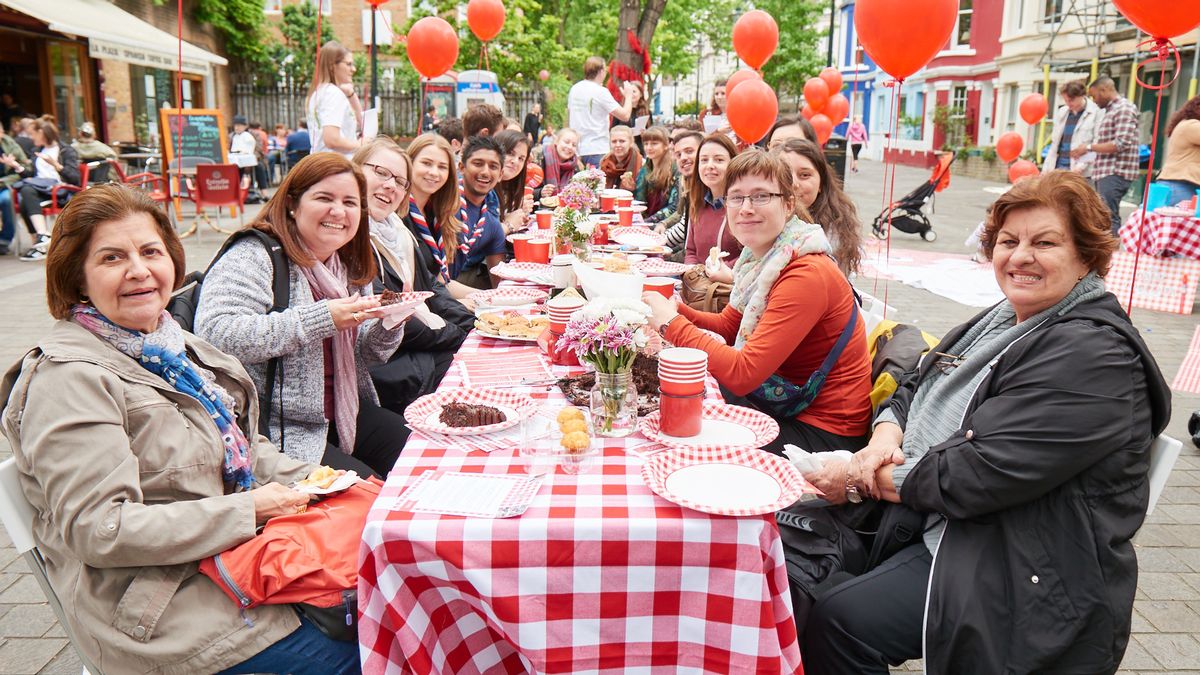
Street party for the Great Get Together.
Defining immersion
Targeting immersion is a key element in the theory of change of strategic communications. The big picture aim of immersion is changing the unwritten rules of culture (or norms) in order to pave the way for a more sustainable change of the written rules of policy and law. The #MeToo movement is a good recent example of how the unwritten rules of culture began to change to the point that certain language and behaviour becomes unacceptable and this leads to strengthened legal responses. Immersion interventions in practical terms include: taking tried and tested narratives to social cohesion work, community engagement or service provision; developing events or experiences in which people from different backgrounds are in contact with one another; and even the feeding in of these new narratives into existing cultural content in TV/film (often known as cultural placement or cultural strategy).
ICPA’s thinking and theory of change has been inspired by Rashad Robinson, from Color of Change USA, who has found the approach of jumping straight from presence (promoting their narratives widely and persistently in public debates through media work and campaigns) to power (advocating for legal and policy change) often is not enough to deliver sustainable and more widely accepted change. Immersing your narrative is a key stepping stone in narrative change activism, that aims for the new narrative to be internalised through deeper experiences and interactions, ensuring the narrative is not only known, but owned.
This case study provides an overview of a narrative immersion project in the UK and the lessons we can take away from it.
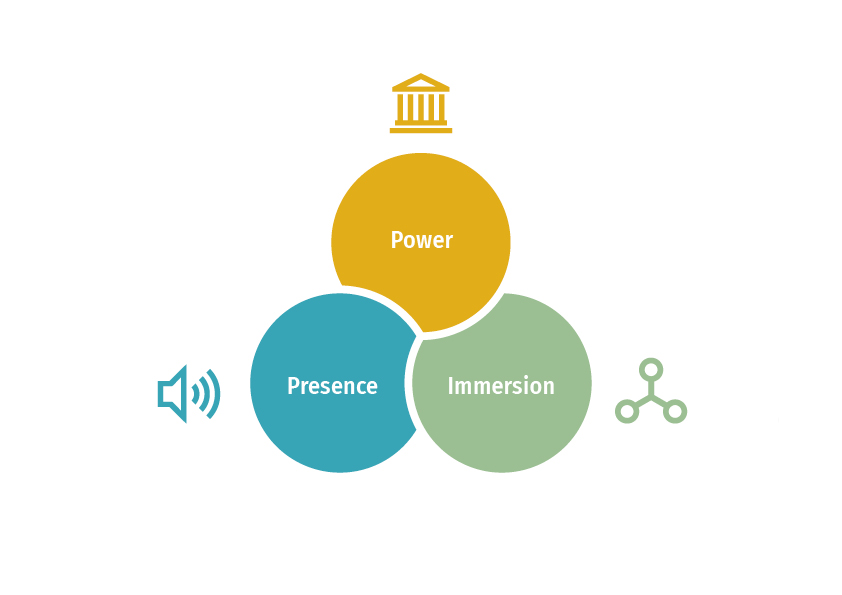
A visual representation of ICPA's theory of change for strategic communications.
The Great Get Together - overview
|
What started as an annual weekend of community events or “Get Togethers” with neighbours in 2017 to celebrate Jo’s message of unity, has turned into a long-term strategy to really immerse the message in people’s everyday lives. Since 2017, millions of people across the country have taken part in thousands of events, from community lunches to sports days, public Iftar street parties to book clubs, to “help bridge social divides and bring people closer together” (GGT) with support from GGT branded resource packs and a digital campaign. It was one of the largest community celebrations to ever happen in Britain. The campaign is based on social contact theory which suggests interpersonal contact is a prime means to reduce prejudice and anxiety between people of different backgrounds (Everett, 2013).1 |
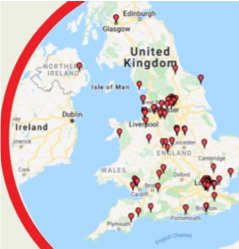
A map of locations where "Get Togethers" are taking place. |
2017-2019: New relationships and initiatives grew out of the 2017 Great Get Together: book groups, football clubs and new residents’ associations continued to operate, and
and More in Common network formalised to supporting community groups to continue spreading Jo’s message and plan for their 2018 Great Get Togethers. Between 2018 and 2019, events and attendance doubled: 2019’s Great Get Together involved 11,000 events, hosting 720,000 people, and 800 resource packs were sent out to more locations. Part of this jump in numbers came from making strategic alliances with organisations with wide reach (e.g. the Youth Sports Trust).
2020-2022 - Despite the Covid-19 pandemic and lockdown in 2020, online and offline events and engagement continued to blossom, from socially distanced outdoor plant/seed swaps to online knitting get togethers or a virtual tour of the local mosques. There was continued coverage in newspapers (including Conservative newspapers) and an expanding social media footprint with over 40 million social media impressions in 2020 and 63 million in June 2021. The events show significant impact for those who participate and organise, see key results from 2021:

Since 2020, the Jo Cox Foundation is implementing the “ From Moment to Movement” strategy to grow the campaign from a moment in June to a year-round movement of social/community action. As part of this, GGT has done the following:
- Established the More in Common Network to help facilitate the growth by convening the 15 volunteer community groups;
- Aligned with partner events (refugee week, loneliness awareness week, volunteers week) with a common cohesion agenda;
- GGT is currently developing a new model: More in Common Partnerships, to further increase sustainability of the events by embedding them in the local council infrastructure.
Lessons:
Five key lessons stand out from the project that offer inspiration and key strategic insights on how to immerse communities in the narrative you want to normalise.
1. Create opportunities for “discovery” of your narrative
Targeting immersion involves a shift from the dissemination of narratives through media campaigns, to the discovery of new narratives through deeper experiences and interactions. Great Get Together organisers highlighted the importance of playful and fun activities which act as ice breakers and connect people in an organic way in which they can “discover” they have “more in common” with their neighbours. These include sports, games, arts and crafts, seed/plant swaps, sharing food and many more. Activities have a “show don’t tell” quality: in their own time, people find their own entry points. Discovery is essential for the sustainability of the “more in common” narrative: in giving people ways to express the narrative in their own words and through what’s relevant to their own communities, narratives become owned and ultimately, internalised.
2. Strategise for a ripple effect
When targeting narrative immersion, design events/interventions that create a ripple effect and act at scale – even when implemented locally. This effect can be seen in the growth of GGT from a commemorative street party around a single event to a much more large scale movement, where event participants become volunteers/organisers in their communities and now run their own events and encourage others to do the same in small and big ways all year round. The target is a sustainable out growth where communities take ownership to create their own discovery moments for their neighbours.
Further, aligning with events and highlighting the work of other networks (e.g. refugee week, loneliness awareness week, volunteers week) creates another vector for the narrative to be kept on the agenda through these “wedge issues” that engage a wider spectrum of the public. Lastly, mobilising local and national political leaders to take part in GGT events further aims to increase the reach of the message though media coverage and even the uptake of the narrative by influential actors. The ripple effect in GGT means the target narratives can be carried across various cultural and political forums to build the self-sustaining momentum to keep the more in common narrative on the agenda.
3. “Hook” your activities onto a recurring entry point
Attaching your work onto a recurring “hook” means it has the potential to repeat over time, build momentum, and really immerse people in the “sustained series of narrative experiences required to enduringly change hearts, minds, behaviours and relationships” (Robinson, 2018).
The GGT started and still has its main event around one recurring hook - Jo’s birthday in June. But pushed to innovate around the pandemic lockdown and wanting to keep the more in common narrative on the agenda, many more community-driven recurring hooks have been added to GGT timeline throughout the year. For example, during December 2022, a community event in Nottingham focused on coming together around festive tea and toast!
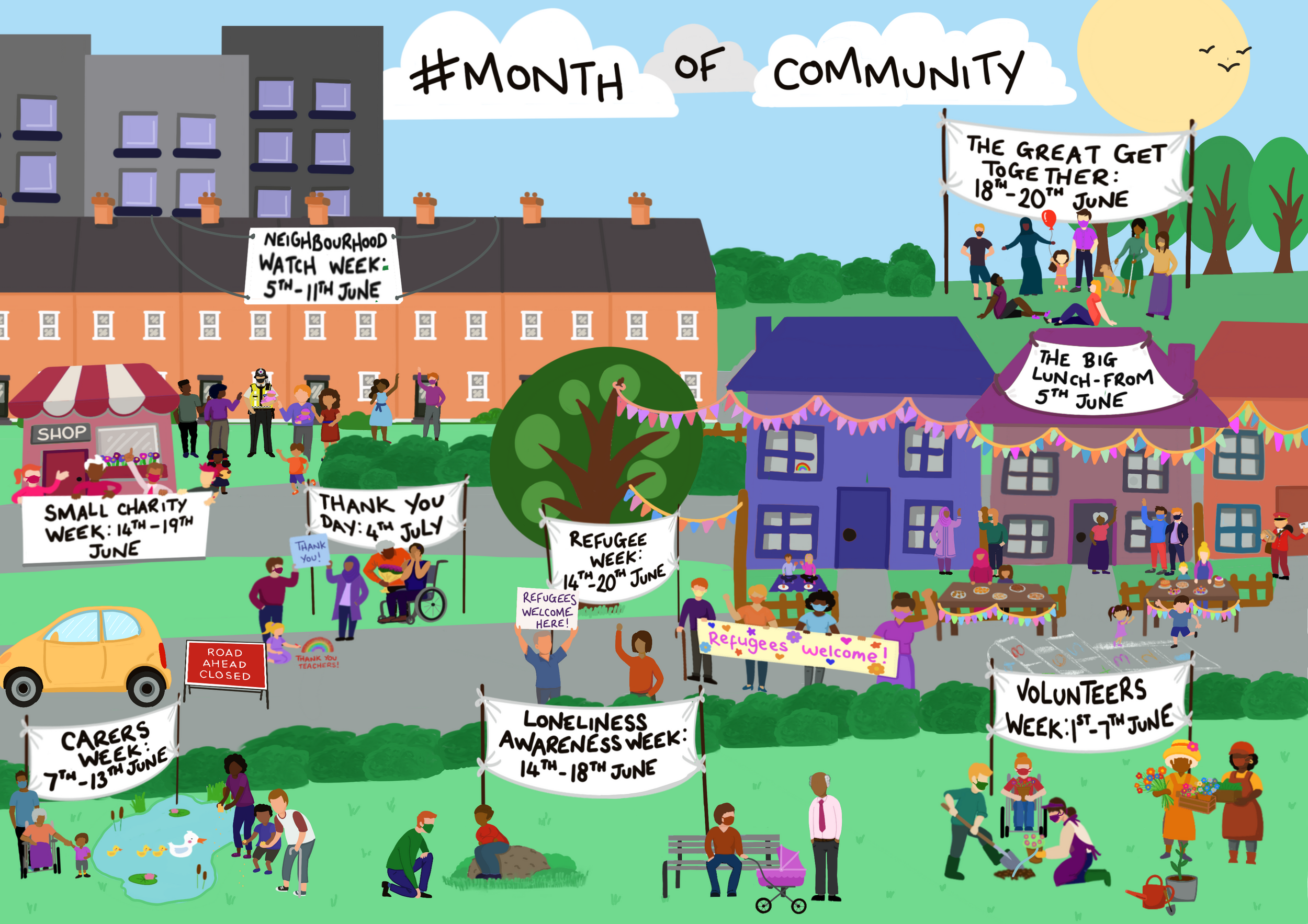
A poster for the "Month of Community" organised by Jo Cox Foundation and partners.
4. Effective immersion initiatives grow like a wild garden
|
As we mentioned in the ripple effect point above, the GGT has created a self-sustaining momentum. But a key tactic for any immersion initiative is to encourage it to grow like a wild garden and take on a life of its own. Seeds of events to immerse the “more in common” narrative were initially sewn, through the Great Get Together signature June neighbourhood lunch. Over time, with GGT encouraging people to be year round volunteers, different variations of “getting together” popped up, adapted by different organisers in different locations, in a way that worked for their local community. For example, the “Great Walk Together”, the “Great Stich Together”, the “Great Seed Swap”, the chattycafe, the “Great Bake Off”, and even free coffees given out by Bately’s railway improvement services at the train station. These events in “ all shapes and sizes” bring the “more in common” narrative to life in their own ways, while still using the branding of the original “Great Get Together”. |
|
The Jo Cox Foundation has articulated this process as finding “the sweet spot between guidance and flexibility” so people have space to tackle issues they see as important in their communities. And very interestingly, they also mentioned that “bigger is not always better”, as small things can often be more striking, local and “powerful”. Only when new narratives reach a level of community-driven authenticity and self-reproducing sustainability does it pave the way for immersion at scale and eventually, a shift in norms.
5. See narrative change as a bridge to power
To be clear from the start, GGT is mostly a community organising project which aims to bring neighbours together to build a more cohesive neighbourhoods, rather than working specifically on particular areas of policy change. The one exception is the issue of loneliness which the organisation uses the insights its broader community engagement to inform and push for smarter policy responses.
However, there are also bridges to power in the community work. Through partnerships with various organisations and local activists who tackle polarising issues (e.g. migration, faith, knife crime) the support of such a big community-led movement brings legitimacy, constituency and coverage to issues that may stay off the agenda and so opens the doors for its many partners to push for policy change. In addition, the Jo Cox foundation is a steering committee member of national coalitions such as the “Together Coalition” – a broad-based platform from civil society, church groups and the private sector targeting political and policy change with a cohesion agenda.
So in sum, shifting public opinion through immersion builds the public support and political will needed to set the ground for changes in policy and law ( achieving power) – and ensures that progressive policies implemented will be more widely accepted and sustainable.
Conclusion
The Jo Cox Foundation supports communities to act locally to develop events to bridge social divides, reach a wide variety of audiences and expand initiatives well beyond the annual GGT, so Jo’s more in common message is socialised in a sustainable manner. The GGT example shows how providing sustainable and fun opportunities to immerse your narrative is a key, often missing step in narrative change activism. This community-focused case study shows in particular how targeting scale and sustainable through a movement approach is key to do effective narrative immersion.
This case study was developed by the ICPA Strategic Communications Incubator team on the basis of analysis of public documents and an interview with Su Moore from the Jo Cox Foundation. Gratitude to Su for generously sharing her experience and thinking.
The case study was developed in the framework of ICPA’s RESET project as part of a set of resources to support the strategic communications work of a network of German activists. Support for researching and developing the case study was provided by:
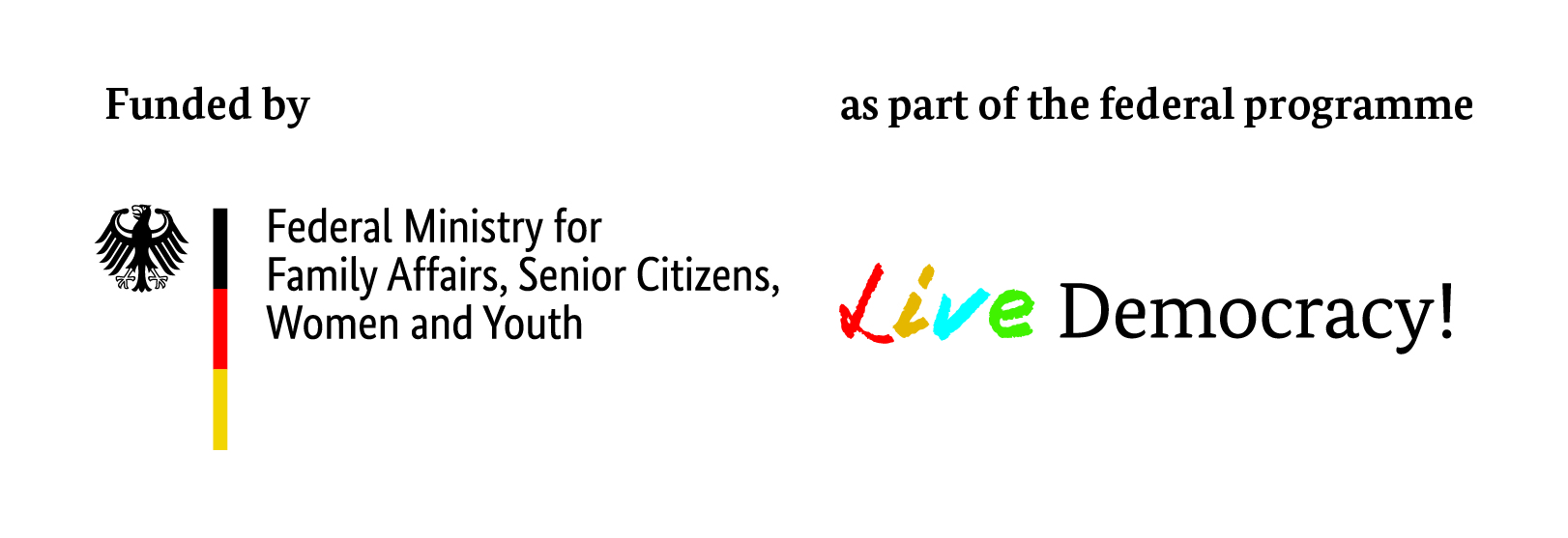
This publication does not express the opinions of BMFSFJ or BAFzA. The authors are solely responsible for the content of the publication.
- 1Everett, J (2013) Intergroup contact theory: past, present and future. Article in The Inquisitive Mind.
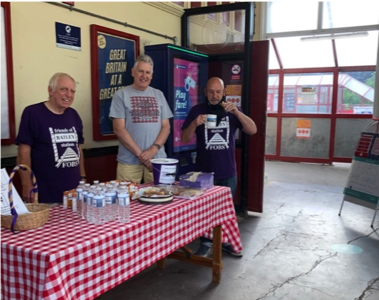 Bately’s railway improvement services "Get Together": handing out free coffees at the train station.
Bately’s railway improvement services "Get Together": handing out free coffees at the train station.